American Line: Pioneers of Transatlantic Passenger Travel and Commerce (1871-1920s)
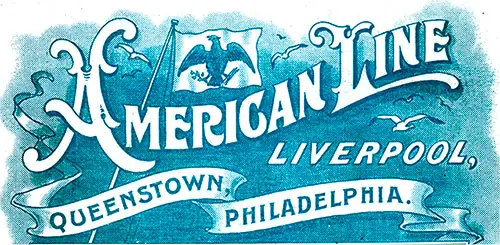
The American Line operated transatlantic steamships that offered weekly express service between Southampton and New York with additional services between the ports of Antwerp, Philadelphia, Queenstown (Cobh) and Liverpool and Philadelphia and Antwerp.
The International Navigation Company, the proprietary organization from, which this Line was developed, was incorporated in Pennsylvania in 1871. In 1873 a fortnightly servioe of steamers was established betweea Antwerp and Philadelphia. under the Belgian flag was known as the Red Star Line. and the American Line was founded in 1880, bringing a weekly service between New York and Antwerp, this ezpansion being followed in 1886. by acquiring the Inman Line.
In 1893 the Inman and International as the Line was then called. became the American Line, and their steamers exchanged Liverpool for Southampton as their port of call. Weekly New York Mail Lines are run to and from Antwerp and Southampton. steamers numiDg between Antwerp and New York can at Dover. A Line is also maintained between Philadelphia. and Liverpool. as well as Antwerp.
Return to Content Links
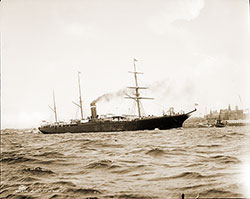
SS City Of Berlin Archival Collection
City of Berlin (1875) Inman Line Ship History (Brief); Passenger Lists; Route Maps, Track Charts, Abstract of Logs; Back Cover Images; Immigrant Documents.
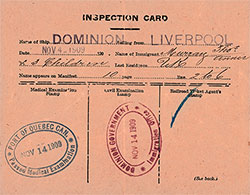
SS Dominion Archival Collection
Dominion (1894) Dominion Line Ship's History (Brief); Passenger Lists; Brochures; Immigrant Documents; Fleet List; Sailing Schedules; Excerpts from Information for Passengers; SS Dominion - 1898.
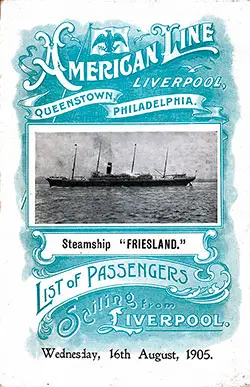
SS Friesland Archival Collection
Friesland (1889) Red Star Line Ship's History (Brief); Passenger Lists; Brochures; Photographs; Illustrations and Paintings; Back Cover Images; Excerpts from Information for Passengers; S. S. Friesland - 1897; The Steamship Friesland - 1908.

SS Haverford Archival Collection
Ephemera for the SS Haverford available may include Passenger Lists, Menus, Brochures, Sailing Schedules, Route Maps, Photographs, and more.
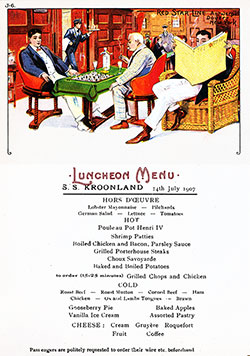
SS Kroonland Archival Collection
Kroonland (1902) Red Star Line Ship History (Brief); Passenger Lists; Menus; Sailing Schedules; Photographs; Postcards; SS Kroonland, Largest Vessel Built in the US - 1902; Red Star Line New York—Dover—Antwerp Service - 1908; Videos.

Ephemera for the RMS Merion available may include Passenger Lists, Menus, Brochures, Sailing Schedules, Route Maps, Photographs, and more.

SS Mongolia Archival Collection
Ephemera for the SS Mongolia available may include Passenger Lists, Menus, Brochures, Sailing Schedules, Route Maps, Photographs, and more.

SS New York Archival Collection
SS New York (1888) American Line Ship's History (Brief); SS New York (1922) Greek Line Ship's History (Brief); SS New York (1927) Hamburg-American Line Ship's History (Brief); Passenger Lists; Brochures; Passage Contracts, Tickets, and Receipts; Menus; Programs; Track Charts; Sailing Schedules; Excerpts from Information for Passengers; Passage Rates; Deck Plans; Photographs; Advertisements; Books; Article: Early History of the American Line; Article: Sister Ships SS New York and SS Paris.

SS Noordland Archival Collection
Noordland (1884) Red Star Line Ship's History (Brief); Passenger Lists; Brochures; Menus; Sailing Schedules; Books Referencing the SS Noordland.

Paris (1889) American Line Ship History (Brief); Paris (1921) French Line Ship History (Brief); Passenger Lists; Brochures; Sailing Schedules; Route Maps, Track Charts, Abstract of Logs; Excerpts from Information for Passengers; Back Cover Images; Other Ephemera; Fleet List; Photographs; Books.

SS Pennsylvania Archival Collection
Pennsylvania (1873) American Line Ship's History (Brief); Pennsylvania (1896) Hamburg-American Line Ship's History (Brief); Passenger Lists; Brochures; Sailing Schedules; Photographs; Route Maps, Track Charts, Abstract of Logs; Excerpts from Information for Passengers; Back Cover Images; The Eighth Voyage of the SS Pennsylvania - 1874.

SS Philadelphia Archival Collection
Ephemera for the SS Philadelphia available may include Passenger Lists, Menus, Brochures, Sailing Schedules, Route Maps, Photographs, and more.

SS Rhynland Archival Collection
Red Star Line Steamer SS Rhynland (1879) at Sea, c1890-1995 (Top Image); Rhynland (1879) Red Star Line (Belgian) Ship's History (Brief); Passenger Lists; Sailing Schedules; Books Referencing the SS Rhynland.

SS St. Louis Archival Collection
St. Louis (1895) American Line Ship's History (Brief); St. Louis (1929) Hamburg-American Line Ship's History (Brief); Passenger Lists; Brochures; Passage Contracts, Tickets, and Receipts; Deck Plans; Passage Rates; Other Ephemera; Sailing Schedules; Photographs; Books; The New Ocean Steamers St. Louis and St. Paul - 1894; Description of the SS St. Louis - 1896.

SS St. Paul Archival Collection
St. Paul (1895) American Line Ship History (Brief); Passenger Lists; Deck Plans; Sailing Schedules; Services; The New Ocean Steamers St. Louis and St. Paul, 1894.

SS Westernland Archival Collection
Ephemera for the SS Westernland available may include Passenger Lists, Menus, Brochures, Sailing Schedules, Route Maps, Photographs, and more.
American Line Immigration Documents
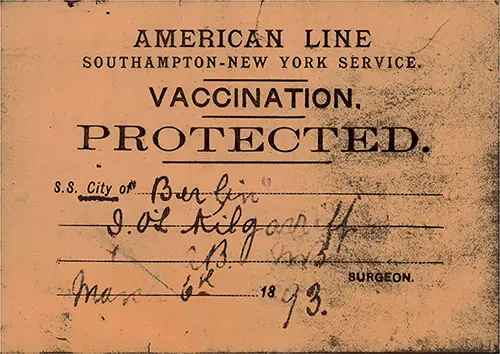
SS City of Berlin Vaccination Card - 1893
This Card was given to a passenger to provide evidence of that passenger's vaccination for smallpox in 1893. UK Immigrant I. Kilgarriff received this Card from the Surgeon on board the SS City of Berlin of the American Line on a voyage from Southampton to New York.
American Line Passage Contracts, Tickets & Receipts

American Line Prepaid Passage Memorandum (1898) – A Rare Look at Transatlantic Travel
This 1898 Prepaid Passage Memorandum from the American Line provides a valuable historical perspective on how individuals traveled across the Atlantic in the late 19th century. Purchased for Second Cabin passage, this document represents one leg of a larger journey, possibly for business, relocation, or family reunification.
This document serves as an essential record of international movement, potentially linking to passenger manifests, census records, and family histories. It is a primary source that showcases how transatlantic travel was financed, arranged, and regulated. It provides insights into social class differences, economic conditions, and migration patterns during the late 19th century.
American Line Brochures
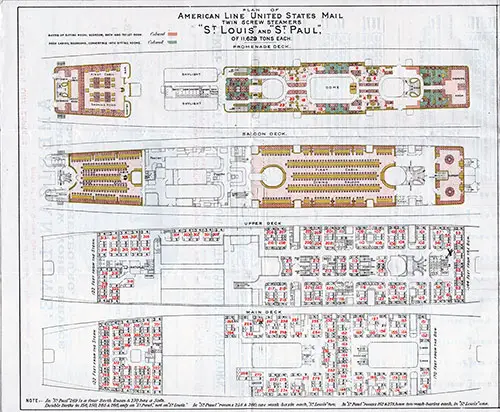
1901-04-22 American Line First Cabin Services
The 1901 Brochure covers the First Cabin Travel on the Steamships of the American Line. It includes Deck Plans, Rates for Transatlantic Travel (Southampton - New York Service via Cherbourg), and General Passenger Information.
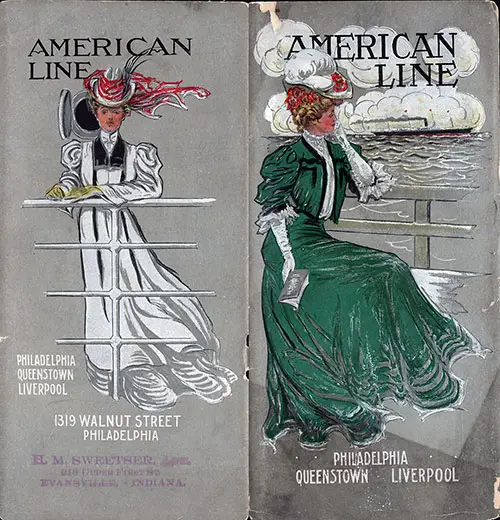
1907 - American Line Philadelphia - Queenstown - Liverpool Service
American Line has specially arranged to accommodate passengers who want good food and service, moderate speed, and the best accommodation the steamers can afford at a reasonable cost.
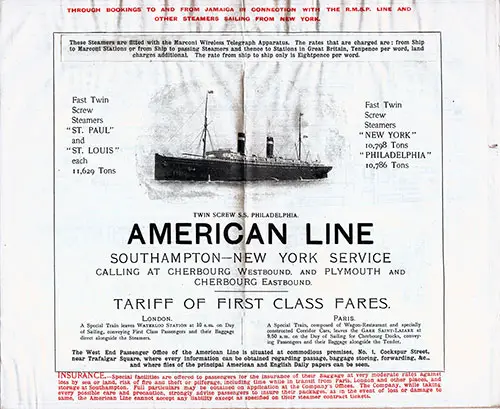
1908-05-22 American Line Southampton to New York Service
Broadside Flyer produced by the American Line promoting their Southampton - New York service. The flyer includes information for passengers, the tariff of first-class fares, and deck plans for the SS St. Louis, SS St. Paul, SS New York, and SS Philadelphia.
American Line Books

The American Line: 1871-1902 (2000)
The American Tine tells the story of the first successful American steamship line after the Civil War to rival the great European transatlantic companies—an essential and glorious chapter in the history of the American Merchant Marine.
American Line New York - Southampton Service
via Plymouth and Cherbourg
Nothing else vividly brings the wonderful development and accomplishment of man's ingenuity as a modem ocean greyhound. The four twin-screw steamers: SS St. Louis, SS St. Paul, SS New York, and SS Philadelphia, maintain the fast express service between New York and Plymouth, Cherbourg, and Southampton and represent the highest type of modern ship construction and equipment.
The call at Plymouth enables passengers (and the American mail) to reach London on special trains via the quickest route. In contrast, from Cherbourg, passengers and mail are conveyed to Paris on the American Line Special Train, carrying dining and lavatory cars. From Southampton—the final port—the run to London is made in one hour and forty minutes. Therefore, the route is ideal for those bound to either Great Britain or the Continent.
In the American Line steamships, the demands of modem travel have been met in all particulars. From keel to the bridge and from stem to stem, they are, in every line, perfect models of modem marine architecture. Structurally they are as staunch and safe as iron and steel can make them. As to comfort, they embody all the luxuries of the decorators' and furnishers' art.
At the same time, these excellent steamers are supplied with ponderous engines, which develop energy sufficient to bring them to their destination despite the stress of wind and wave, with almost the same regularity that characterizes the scheduled running of express trains on shore. Furthermore, nothing in the way of safety has been sacrificed to speed—a statement supported by the fact that insurance companies assert that travel by water nowadays is, in reality, far safer than travel by land.
Twin Steamships St. Louis and St. Paul
The SS St. Louis and SS St. Paul are the fastest and finest transatlantic steamers ever turned out of an American shipyard. The product of the William Cramp & Sons Ship and Engine Company of Philadelphia, they are a pride to the nation as well as to their builders, for the American Line is the only transatlantic steamship line flying the American flag and is under contract with the United States Government to carry the United States mails.
Being intended for fast mail service and use as auxiliary cruisers in the event of war, they were constructed under certain specifications of the United States Government, in addition to the rigid requirements of Lloyds and Bureau Veritas. The Government demanded a speed of twenty knots, which has frequently been exceeded in actual service. When finished, they passed a thorough inspection by government experts and were found to meet the stipulations in every respect.
The principal dimensions of these sister ships are:
- Length overall, 554 feet.
- The length of the water line is 535 feet.
- The breadth of the beam is 63 feet.
- Molded depth, 42 feet.
- Gross tonnage, 11,629.
They have two masts and two funnels, each accommodating 366 first-class, 200 second-class, and 800 third-class passengers, a total of 1366.
These steel vessels, built with double bottoms, are made up of seventeen independent sections, each division being a watertight compartment in itself. Transverse bulkheads extending from the keel upwards to the saloon deck, eighteen feet above the load water line, separate these.
Bilge keels, extending underwater over half the vessel's length, protrude from both sides of the hull like two great fins and tend to steady the ship in a sea-way.
The engine rooms are as attractive as an art gallery. The engines are of the quadruple expansion type, with built-in duplicates to drive massive propellers. The lifeboats and rafts are carried on the awning deck (reserved entirely for navigating purposes) where, without interference, they can be launched quickly and easily.
Ample walking space is provided on the promenade deck. Five hundred ten feet in length and cozy alcoves or recesses in the sides of the deckhouse offer just enough retirement and space for steamer chairs where one may lounge in comfort, sheltered from the strong breezes.
Ladies and children find rest and quiet in the drawing room, with its softly cushioned divans upholstered in light brocade of delicate threads. The windows are gracefully draped with silken tapestries, and electric bulbs in the paneled ceiling softly illuminate the cabinetwork in an ivory finish. Windows at the forward end command a fine view of the deck where one may watch the ship's progress. This room is also provided with an excellent piano.
The smoking room, also situated on the promenade deck, is handsomely finished in a dark wood, with panels of blue and leather fittings. It accommodates about 100 persons and is often the center of masculine interest.
Within the deckhouse and communicating with the promenade are sumptuously furnished suites comprising a bedroom, sitting room, and bathroom. These, of course, are for those who desire the privilege of seclusion with great appointments. All the suites are furnished in attractive and harmonious color schemes and represent the acme of luxurious ocean travel.
On the deck below the promenade is the dining saloon, whose spacious proportions can accommodate 366 persons, the ship's entire complement of first-class passengers, with seats at once.
This apartment is situated where there is the slightest motion—amidships, between the two funnels—and is lighted from above by a substantial paneled dome of glass, artful in its curving proportions and color treatment and extending the entire length of the saloon. This dome, which has attracted universal admiration, rises to a height of twenty feet, with an arch span of fifty-three feet.
At the sides of the room, in place of the usually contracted port holes, are large rectangular windows assuring perfect ventilation. Small tables in place of the long ones so often found on trans-Atlantic steamers have made the saloon unusually cozy in appearance.
The keynote of the decorative scheme throughout the ships is brilliance. The light has been preserved by avoiding dark colors. The whole tone of the dining saloon is one of refinement. The wood employed is white mahogany. The panels supporting the enormous glass dome represent sea nymphs disposed of in attitudes of playful sports of the sea.
Two stunning works of sculpture by the famous artist, Karl Bitter, adorn the ends of the saloon and are placed in the arched spaces under the glass dome. At the forward end is an emotional scene, the principal figure of which is a graceful mermaid whose outstretched arms sustain the gallery of the saloon and above which are to be seen the gilded pipes of the great organ. In the after space is a figure of Neptune grasping his trident in an attitude of supremacy over the tumultuous waves among which he is seated.
Directly forward of the dining saloon opens the main companionway. A handsome double staircase with treads of easy ascent, from which the library is reached, a magnificent room finished in oak, said to be the largest apartment ever devoted to library purposes on a trans-Atlantic steamer. The bookshelves contain over one thousand choice works of literature, which are available to passengers at all times.
Abaft, the main saloon is the pantries—separate ones for the first and second-class. On these vessels, the kitchens—carefully isolated—constitute an interesting department. Models of modem convenience and cleanliness are under the command of experienced chefs who prepare appetizing and varied menus.
Immediately aft of these is the second-class saloon, ample and unusually commodious in its accommodations and attractive in every way.
The extensive area of the upper and main decks is wholly allotted to passenger accommodations, the central sections being given over to first-class staterooms. These rooms are considerably larger than usually found on board ship and are finished in white, kept spotlessly clean. The fittings always give good variety to please the eye.
The color scheme for the upholstery is steel blue for one deck and old gold for the other; and in the interest of absolute cleanliness, which is essential to good health; there has been no effort at useless decoration.
The second-class rooms are placed immediately above the first-class, the quarters for third-class passengers being forward and aft of the first and second-class cabins. In reality, the second-class apartments are as comfortable and well-ventilated as the first-class quarters on many other vessels, and their fittings are most attractive.
The ladies sitting room is tastefully finished in cherry, with appropriate color paneling. One of the most attractive rooms on the ship is the second class smoking-room, which is prettily furnished in birch and cherry. The dining saloon is a lovely apartment, beautifully upholstered and decorated. There is seating accommodation for 210 passengers.
Ventilation has always been one of the most severe problems of ship construction. Still, it has been solved most ingeniously on these vessels. A plant of Sturtevant blowers on the upper deck maintains a steady but almost imperceptible breathing of fresh air from the ocean into all parts of the ship. A unique aspect of the promenade deck is set apart where second-class passengers may enjoy exercise and recreation.
In cold weather, the air passes over steam pipes, and the heat supplied may be regulated for each deck independently. Further, the passenger may control the heat and ventilation in his stateroom utilizing valves, which are placed near the top and the bottom of every apartment. With this superior system, the inner rooms throughout the ship are kept as comfortable and fresh as the outer ones, and running steam pipes through each cabin is no longer necessary.
The Twin Steamships New York and Philadelphia
The SS New York and SS Philadelphia embody the best skill, artistry, and all that is modern and up-to-date in marine architecture. In safety, speed, and comfort, they occupy the highest rank. The SS Philadelphia was rebuilt in 1901 by the famous firm of Belfast shipbuilders, Messrs. Harland & Wolff, Limited, and the William Cramp & Sons Ship and Engine Building Company, at Philadelphia rebuilt the SS New York in 1903.
The principal dimensions of these two sister ships are as follows:
- Length overall, 576 feet
- Length on the water line, 525 feet
- The breadth of beam 63 feet
- Molded depth, 42 feet
- Gross tonnage, 10,800
- Promenade deck, 550 feet in length
Both steamers, like the SS St. Louis and SS St. Paul, are constructed with bilge keels, which steady them materially when in a seaway.
The hulls are made with double bottoms throughout, and Siemens-Martin steel was exclusively employed in the outer structure. The sectional plan further assures their safety of construction, there being in each ship fifteen watertight divisions, each compartment about 35 feet long, separated by solid steel structural bulkheads of immense strength.
Each bulkhead extends from the keel to the saloon deck, rising eighteen feet above the load water line. The staterooms of the first-class passengers occupy three watertight compartments in the central part of the vessel.
Directly aft is two compartments set apart for the second-class passengers. At the same time, the spaces at the bow and stem are devoted to third-class accommodations.
Three of the watertight compartments are reserved for the boilers and one for the engines, which are in duplicate, completely separated from each other by a longitudinal bulkhead, so that in case one set of machinery should be disabled, the ship could still proceed under the power of the different group.
Externally the SS New York and the SS Philadelphia are two of the most beautiful steamships. Their lines are those of a yacht, with graceful, bowspritted stems and long overhang stems; each has three masts and two funnels.
The grandest internal feature of these ships is, beyond all doubt, the first-class dining saloon, which is located on the saloon deck. It is a room of noble proportions and extends almost entirely across the ship. Unlike on most steamers, the dining saloon is carried to an immense height through two decks and a half and is surmounted by a cathedral glass dome of magnificent design and exquisite coloring.
The total height is twenty feet, while the length of the arched roof is fifty-three feet, with a span of twenty-five feet. In this grand saloon, there are dining places arranged for 271 passengers. At one end of the dining saloon, and under the gabled archway formed by the domed ceiling, is the grand organ loft accessible from the promenade deck.
Cozy-little alcoves are arranged around the sides of the saloon fitted with small athwart ship tables for those who seek home-like privacy. A beautiful oriel window, communicating with the ladies' drawing room, occupies the other end. The small tables in the center of the saloon, seating but a few passengers each, are disposed longitudinally with the ship's length, and the revolving armchairs are beautifully upholstered and most comfortable.
Well-known artists have collaborated to decorate the dining saloon most charmingly. A white composition of peculiar ductility was used to garnish the arch and organ loft woodwork. The paneling is gorgeously embellished by representations of dolphins, sea nymphs, and tritons in graceful postures. A large clock is embedded in the front of the gallery, while a vast gilt lyre surmounts the encasement of the organ.
The drawing room is a perfect gem, adorned and appointed with exquisite taste. The white paneled walls and ceiling, striped with gold, give light and brilliance to this apartment. It is a favorite haunt of the lady passengers in both fair weather and foul.
Plateglass mirrors adorn the side walls, and the furniture of polished mahogany and red upholstery harmonizes perfectly with the polished oak floor and Oriental coverings. An upright grand piano completes the apartment as a social center, and pleasant musicals are often held here.
Easy access is had to the promenade deck, with its comfortable steamer chairs and attractive sea games. Leading up to the drawing room, and at after the end of the main saloon, is the grand staircase, or main companionway. It rises by easy treads from a spacious vestibule opening on either side to the promenade deck.
On the after side of the stair hall is the lounge, another elegantly furnished apartment, oddly constructed in the form of an hourglass. This form secures an excellent light at all room points. The titles of the thousand or more well-selected volumes invite the passenger to delve into their delights.
Passengers may take books from the library at any time during the voyage. A wainscoting of oak is made interesting by including the names of illustrious authors within the score or more panels. At the same time, one's attention is arrested by numerous quotations from sea poems inscribed upon stained glass windows at the room's sides.
The smoking room, very handsomely and comfortably appointed, its dimensions being 45 feet long by 27 feet wide, is the retreat of the men who delight in the pleasures of tobacco.
There are numerous suites and deck cabins upon the promenade and saloon decks, with private baths and lavatories. The bedrooms in the suites are fitted with single and double beds, the berths being, as in a Pullman car, closed up during the day.
An awning deck protects the promenade deck, which practically extends the entire length of the vessel overhead, and lifeboats hang clear of everything at eight feet.
The second-class dining saloon is a most inviting apartment 45 feet long and 40 feet wide, well-ventilated and well-lighted, providing places for 133 passengers. It contains a fine piano and a well-stocked library of choice books. It provides a pleasant place for concerts and entertainment for second-class passengers. The ladies' room and the smoking room in second-class are pleasantly situated upon the promenade deck.
The third-class passengers are located in suitable accommodations. Rooms containing two, four, or six berths are provided for married couples and families, the berths being of metal, with woven-wire bottoms, ensuring perfect cleanliness. The Company offers comfortable beds and blankets.
Single men and women are berthed in separate compartments, and matrons attend to mothers and young women traveling alone.
The American Line steamers provide large, well-ventilated dining rooms for third-class passengers. These are also used as sitting rooms, and a piano in the dining room adds to the passengers' pleasure for frequent evening entertainment.
The third-class sections are fitted throughout with excellent lavatory and bathroom accommodations. On both sides of the steamers, the whole deck is reserved for third-class passengers who desire to use it for exercise. The new ventilating system, already described as in service on the SS St. Louis and SS St. Paul and has proved so thoroughly effective and practical, has also been installed on the SS New York and SS Philadelphia.
International Mercantile Marine Company, "American Line, New York-Southampton Service," Facts For Travelers: American Line, Atlantic Transport Line, Dominion Line, Leyland Line, Red Star Line, White Star Line, 1908: P. 7-18.
American Line Philadelphia - Queenstown - Liverpool Service (1908)
Cabin Passengers Carried in One Class Only
SOME years ago, to meet the public's demand for passage to and from Europe at nominal rates, the American Line discontinued carrying passengers in first class on its service between Philadelphia, Queenstown, and Liverpool and limited the ships to second-class and third class. The idea has been thoroughly appreciated by a large section of the traveling public, who, while requiring the best the ship affords, do not care to pay the higher rates demanded in the vessels carrying first and second-class passengers.
The significant and ever-increasing number of travelers who elect to take passage by this route attests to its popularity. From time to time, larger and more comfortable vessels have been added so that the steamers, which maintain this service, are thoroughly up-to-date and are built and equipped in an entirely modern manner.
The fleet now consists of the twin-screw steamships SS Haverford and SS Merion and the SS Friesland, SS Westernland, and SS Noordland.
All of these ships are specially adapted to the plan of carrying passengers in one cabin class only. The accommodation, situated in the best portion of the steamer, includes the spacious promenade deck, ladies' room, smoking room, etc., all amidships. These steamers are also fitted to transport many third-class passengers in departments of the ship entirely isolated from the cabin passengers.
In the furnishings and fittings of these vessels, the cabin passenger will find every comfort and luxury. When the minimum price is considered, the service given is extraordinary. It is no little satisfaction to the American Line to know and record that the chief advertising of this route is accomplished by patrons who have made it a point to inform their relatives and friends of their delightful experiences while crossing the ocean on the steamships in this service.
The Twin-Screw Steamships Haverford and Merion
Messrs. John Brown & Co., Limited, of Clydebank, built the new twin-screw steamships SS Haverford and SS Merion. They were designed to carry large cargoes, yet equipped with such powerful boiler and engine installation that sufficient speed could be maintained to warrant further fitting them with extensive passenger accommodations. The weight of the immense cargoes gives them excellent steadiness at sea, which is additionally insured by the presence of bilge keels.
The principal dimensions of the SS Haverford and SS Merion are Length, 547 feet; breadth of beam, 59 feet; gross tonnage, 11635.
Built of steel on the modern compartment plan, these vessels contain watertight bulkheads so arranged that any two compartments might be flooded with water without endangering the ship's safety. Powerful engines maintain a speed of about fourteen knots an hour. The extra heavy twin-screw shafts are encased in plating to their outer ends. At the same time, the coal bunkers, of immense capacity, are so arranged as to afford perfect protection to the boilers in case the vessel should be used for war purposes.
The bridge house, extending above the shelter deck, is 150 feet long and covers the entire ship's width. Our extensive and airy staterooms—nine two-berth rooms and thirty-three four-berth rooms—afford cabin accommodations for 150 passengers. Baths and lavatories of solid porcelain are conveniently located in the most approved types.
The handsomely furnished and pleasingly decorated dining saloon is at the forward end of the deckhouse. It is finished in light oak paneling, and a novel grouping of the side ports, arranged in pairs, gives an abundance of light. The appurtenances of the dining room are complete in every detail, and an excellent piano is provided.
The main promenade, which extends the entire width of the vessel, offers a delightful recreative ground, and on this deck of the ship will be found the library, a long, cheerful, and well-ventilated room supplied with many handsomely bound volumes of the classics and much interesting literature of the day.
The ladies' salon, a beautifully appointed apartment, the richly upholstered divans, and easy chairs invite comfort. During the voyage, the room is constantly in use. The spacious entrance hall adjoins this apartment, and the captain's and officers' quarters are also on this deck. Another entrance lobby at the end communicates with the library on the port side and a luxurious smoking room on the starboard side—a room most popular with the men's passengers.
The Steamship Friesland
The SS Friesland is a four-masted, single-funnel steamship of immense proportions, built of the best steel at the famous Glasgow yards of Messrs. James and George Thomson and constructed on the same lines as the famous clipper-model steamships Philadelphia and New York. She has a double cellular bottom and nine water-tight bulkheads, making her practically unsinkable, being accorded the highest class in Lloyds and Bureau Veritas. The Friesland's principal dimensions are Length, 470 feet; breadth, 51 feet; gross tonnage, 6,409.
This yacht-like ship has three decks, the rooms for cabin passengers being amidships on the saloon and upper decks. In contrast, the promenade deck extends two-thirds of the vessel's entire length.
The most attractive feature of the SS Friesland is the dining saloon, located well away from the machinery. It is an airy room of spacious proportions and beautifully lit by a vast dome-shaped skylight. The cabinet work is finished in elaborately carved oak. In contrast, the relief work of the pure white ceiling is delicately picked out in gold leaf.
Many desirable staterooms are located on the saloon deck. They are always in demand because they are unusually well-lighted and have perfect outside ventilation. With its richly carved balustrade, the main companionway is worthy of a fanciful yacht.
The smoking room on the promenade deck is finished in dark mahogany with decorated tile panels, and the tiled floor ensures absolute cleanliness. It is an attractive gathering place, as is the music-room at the head of the main companionway.
The Popular Steamships Westernland and Noordland
The SS Westernland and the SS Noordland are sister ships in all but a few minor particulars. One description will suffice for both. They were built after the same model by the well-known firm Messrs. Laird & Brothers in Birkenhead, England. In exterior appearance, however, they are different, as the Westernland has two funnels and the SS Noordland one. However, both have four masts. After the most approved methods, their construction is entirely steel, with watertight bulkheads and compartments.
The principal dimensions are SS Westernland—Length, 455 feet; breadth of beam, 47 feet; gross tonnage, 5,708. SS Noordland—Length, 416 feet; breadth of beam, 47 feet; gross tonnage, 5,150.
Their great beam gives these steamers exceptional steadiness at sea in proportion to their length. It affords extra space for passengers, especially on the promenade deck. A broad, easy staircase connects this deck with the saloon and upper decks, on the latter of which is located the drawing room, richly furnished and upholstered in moquette. Amidships is the smoking room, most comfortably and attractively fitted.
The dining saloon is finished in hardwoods and tastefully decorated, and the upholstery is a rich frieze plush. The ventilation is perfect, and the pantries and galley are so arranged that the cooking odors cannot invade the dining saloon. The entire ship is brilliantly lit by electricity.
Many upper-deck amidship staterooms are finished in polished mahogany and are incredibly comfortable, well-lit, and ventilated. On the SS Noordland, many especially desirable rooms have been built on the saloon deck in a delightful situation.
International Mercantile Marine Company, "American Line, Philadelphia - Queenstown - Liverpool Service," Facts For Travelers: American Line, Atlantic Transport Line, Dominion Line, Leyland Line, Red Star Line, White Star Line, 1908: P. 19-23
Recap & Summary: American Line Archival Collection
The American Line was one of the most influential transatlantic shipping companies operating between the United States and Europe in the late 19th and early 20th centuries. Established under the International Navigation Company in 1871, it became a crucial player in U.S.-European immigration, mail transport, and ocean travel, serving ports such as New York, Southampton, Liverpool, Antwerp, Queenstown (Cobh), and Philadelphia.
This archival collection offers an extensive historical perspective, featuring passenger lists, ship histories, brochures, deck plans, and travel ephemera, providing genealogists, historians, and maritime enthusiasts with valuable insights into early transatlantic voyages.
1. The Evolution of the American Line
Company Growth & Expansion
- The International Navigation Company was founded in 1871 and initially operated under the Belgian flag as the Red Star Line between Philadelphia and Antwerp.
- The American Line was formally established in 1880, offering weekly express service between New York and Antwerp.
- In 1886, the company acquired the Inman Line, expanding routes to Liverpool and increasing its influence in transatlantic shipping.
- By 1893, the Inman and International Navigation Company fully merged into the American Line, marking the company's peak in weekly transatlantic mail and passenger services.
🔹 Why it’s interesting:
- The American Line played a significant role in U.S. immigration, transporting thousands of European immigrants to Ellis Island and Philadelphia.
- Its growth and acquisitions helped establish the U.S. as a competitive force in transatlantic passenger shipping, challenging British and German lines.
2. The American Line Fleet: A Legacy of Iconic Ships
The American Line operated some of the most advanced steamships of its era, catering to luxury travelers, immigrants, and cargo transport.
Flagship Vessels & Their Contributions
SS St. Louis & SS St. Paul (1895)
- Built at William Cramp & Sons Shipyard in Philadelphia, these were the fastest transatlantic liners built in America at the time.
- They exceeded the U.S. Government’s 20-knot speed requirement, making them ideal for express mail and passenger service.
- Key Features:
- 11,629 gross tons, 554 feet in length, and quadruple expansion engines.
- Elegant first-class accommodations, including spacious promenade decks, luxurious dining saloons, and private suites.
- Designed for conversion into auxiliary cruisers during wartime.
🔹 Why it’s interesting:
- These ships were symbols of American shipbuilding excellence, designed to rival British and German luxury liners.
- Their dual role as commercial steamers and potential wartime cruisers highlighted their strategic importance.
SS New York & SS Philadelphia (1888, Rebuilt in Early 1900s)
- Originally Inman Line vessels, these ships were modernized under the American Line to improve speed and luxury.
- Main Features:
- 576 feet long, 10,800 gross tons, and built with bilge keels for stability.
- First-class dining saloons with grand cathedral-like domes, drawing rooms with upright pianos, and luxurious smoking rooms.
- Steel hulls with watertight bulkheads, ensuring maximum safety at sea.
🔹 Why it’s interesting:
- These ships were known for their opulence, catering to elite travelers and European aristocracy.
- They represented the golden era of transatlantic luxury travel, before the dominance of Titanic-era superliners.
SS Haverford & SS Merion (1901)
- Built for cargo and passenger service, these ships featured expansive second-class accommodations.
- Key Features:
- 547 feet long, 11,635 gross tons, built with steel double bottoms for safety.
- Well-furnished libraries, smoking rooms, and ladies’ salons for passengers.
- Carried large numbers of immigrants in comfortable but economical cabins.
🔹 Why it’s interesting:
- These ships made ocean travel accessible to middle-class travelers, offering a balance between affordability and comfort.
- They played a crucial role in mass European immigration to America, transporting thousands of newcomers seeking a better life.
SS Friesland, SS Westernland, SS Noordland
- These ships catered to one-class second-class travel, a budget-friendly yet comfortable alternative to luxury steamers.
- The Friesland (built in Glasgow) featured a grand dome-lit dining saloon and was considered unsinkable due to its double-bottomed steel construction.
- The Westernland and Noordland were known for their stability and spacious promenade decks, making them ideal for comfortable travel.
🔹 Why it’s interesting:
- These ships reflect the diversity of ocean travel, serving both elite passengers and working-class immigrants.
- Their steady voyages helped increase transatlantic tourism and economic migration.
3. Passenger Experience: A Journey Through Time
The American Line was known for its comfort and efficiency, catering to different classes of travelers.
First-Class Experience
- Luxury suites with private bathrooms and spacious promenades.
- Gourmet dining with elaborate menus, often featuring fresh seafood, roasts, and imported wines.
- Exclusive lounges, smoking rooms, and music halls with live performances.
🔹 Why it’s interesting:
- The American Line’s first-class offerings rivaled the finest European ships, attracting wealthy travelers, politicians, and business elites.
Second-Class & Third-Class Travel
- Affordable yet comfortable accommodations with smaller cabins and shared facilities.
- Dining halls serving simple but nutritious meals, with entertainment provided in common areas.
- Many immigrants traveled in these classes, making the American Line one of the main carriers of U.S.-bound European settlers.
🔹 Why it’s interesting:
- The experience of second-class and third-class travelers mirrors the immigrant journey, capturing the aspirations of millions seeking a new life in America.
4. The American Line’s Role in Immigration & War
Key Contributions to U.S. Immigration
- The American Line played a major role in bringing immigrants from Europe to Ellis Island and Philadelphia.
- Ships like the SS Westernland, SS Noordland, and SS Friesland transported thousands of European settlers, particularly from Germany, Belgium, and the UK.
- Passenger manifests and immigrant inspection cards provide genealogical records for those tracing family history.
World War I Service
- Several American Line ships were converted into troop transports, assisting in U.S. military operations in Europe.
- The SS St. Louis and SS St. Paul were requisitioned as auxiliary cruisers.
- Many American Line vessels were targeted by German U-boats, highlighting the dangers of wartime travel.
🔹 Why it’s interesting:
- The American Line was not just a commercial venture—it was a vital link in U.S. military and immigration history.
5. The Legacy of the American Line
By the 1920s, the rise of larger superliners and aviation led to the decline of the American Line. It was eventually absorbed into the International Mercantile Marine Company, marking the end of an era for U.S. steamship dominance.
Why This Collection Matters
✅ Genealogists – Passenger lists and immigration records provide a goldmine for ancestry research.
✅ Historians & Educators – Learn about early American maritime commerce and immigration patterns.
✅ Maritime Enthusiasts – Discover the golden age of transatlantic ocean travel.
Conclusion: A Pioneering American Steamship Line
The American Line was a symbol of U.S. maritime ambition, bridging continents and shaping transatlantic travel for nearly 50 years. Whether transporting immigrants, aristocrats, or soldiers, its fleet left a lasting impact on U.S. and European history.
